History of Judo
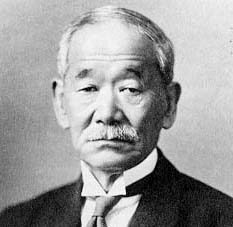
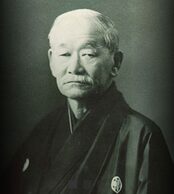
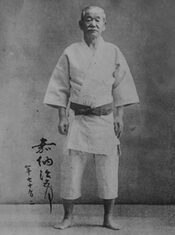
As a boy, Kano was an undersized, slender, weak, and sickly child with one sickness after another. Against his doctor's advice, Kano decided to do something to improve his health and at the same time learn how to defend himself against bullies. At the age of 18 he enrolled in the Tenjin Shinyo ryu school of jujitsu. Under the guidance of Fukuda Hachinosuke, Kano began his long journey to physical well-being. The Tenjin Shinyo ryu was a soft martial art that stressed harmony rather than combat, yet at the same time included striking and grappling techniques.
After studying at the Tenjin Shinyo ryu, Kano transferred to the Kito ryu school to study under Tsunetoshi Iikubo. This brand of jujitsu was much softer and stressed moderate workouts with attention given to freedom of action, the abstract symbolism connected with physical technique, and throwing techniques.
It was during these times that Kano began a comprehensive and systematic study of other forms of jujitsu such as sekiguchi-ryu and seigo-ryu. He started this project out of respect for his masters, but he soon he craved for a mental knowledge that was lacking in their teachings. He sought to understand the superior control that his teachers had mastered. He also studied the manuscripts developed by the founders of various schools, the I Ching, (Book of Changes), and Lao-Tsze's philosophy.
Around 1880 Kano started rethinking the jujitsu techniques he had learned. He saw that by combining the best techniques of various schools into one system he could create a physical education program that would embody mental and physical skill. In addition, he believed that the techniques could be practiced as a competitive sport if the more dangerous techniques were omitted.
So in 1882, having pulled from ancient jujitsu the best of its throws and grappling techniques, added some of his own, and removed such dangerous techniques as foot and hand strikes. Kano at the age of 22, presented his new sport--Judo. He called this sport Kodokan Judo. The term Kodokan breaks down into ko (lecture, study, method), do (way or path), and kan (hall or place). Thus it means "a place to study the way." Similarly Judo breaks down into ju (gentle) and do (way or path) or "the gentle way."
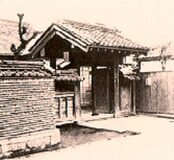
Kano established his Judo school, called the Kodokan, in the Eishoji Buddhist temple in Tokyo which grew in size and later moved. The first Kodokan had only 12 mats (12 feet by 18 feet), and nine students in the first year. Today the Kodokan has over 500 mats and more than a million visitors a year.
Kano's devotion to Judo did not interfere with his academic progress. He pursued his study of literature, politics and political economy, and graduated from Tokyo Imperial University in 1881.
In 1886, because of rivalry between jujitsu schools and Judo, a contest was held to determine the superior art. Kano's Judo students won the competition easily, thus establishing the superiority of Judo, its popular principles and its practical techniques.
The categorization of Kodokan Judo was completed about 1887. The Kodokan had three broad aims: physical education, contest proficiency and mental training. Its structure as a martial art was such that it could be practiced as a competitive sport. Blows, kicks, certain joint locks, and other techniques too dangerous for competition, were taught only to the higher ranks.
Starting in 1889 Kano left Japan to visit Europe and the U. S. He traveled abroad a eight times to teach Judo and several times to attend the Olympics and its committee meetings. Often in the face of extreme hardship, several of Kano's students devoted their lives to develop Judo in foreign countries.
On July 24, 1905, representatives of the leading jujitsu schools (ryu) of Japan, gathered at the Butokukai Institute in Kyoto to agree upon the forms of Kodokan Judo and to continue the development of the technical forms of the sport. The ancient jujitsu techniques of each particular school were to be preserved in kata (pre-arranged form) for posterity.
In 1909, the system underwent a big change and the Kodokan became an official Japanese foundation. In the same year Jigoro Kano became the first Japanese member of the International Olympic Committee
By 1910 Judo was a recognized sport that could be safely engaged in and in 1911 it was adopted as a part of Japan's educational system. In the same year, the Kodokan Judo Instructors' Training Department, Kodokan Black Belt Association and Japan Athletic Association were formed. Beginning with the fifth Olympiad in Stockholm, Kano attended every Olympic Game and International Olympic Committee meeting and became a leading figure in international sport.
The Kodokan mottoes, Seriyoku-zenyo (maximum efficiency) and Jita-kyoei (mutual welfare and benefit), emphasize moral and spiritual training in addition to the physical training of Judo. The ultimate goal of Judo was to perfection the individual so that he can be of value to society. This spiritual phase developed gradually and was completed around 1922.
Apart from being an innovator and administrator, Kano was also a skilled player as testified to by a high-ranking Judoka who, when asked about his experience in competing against Kano, said, 'It was like fighting with an empty jacket"!'
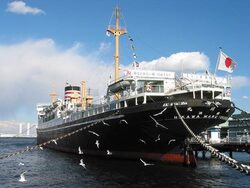
S.S. Hikawamaru
Before the great expansion in air travel that started in the 1950s, most passengers journeyed overseas on ocean liners. One of the ships that often sailed the Japan - U.S.A. routes was NYK Line’s workhorse the Hikawamaru. This cargo-passenger liner reportedly made the two-week trip between Yokohama and the then gateway to the US, Seattle, 254 times between 1930 and 1960 when she was finally decommissioned and became a floating restaurant and later refurbished (2006-2008) and reopened as an Important Cultural Property permanently moored at the port of Yokohama. Professor Jigoro Kano, who made some 13 extended overseas trips in his lifetime, on occasions voyaged on the Hikawamaru, as did many other celebrities of the day.
A famous episode occurred on board the ship during one of his voyages. A foreigner made fun of Kano, he threw the man down, but put his hand under the man's head to prevent him from getting hurt.
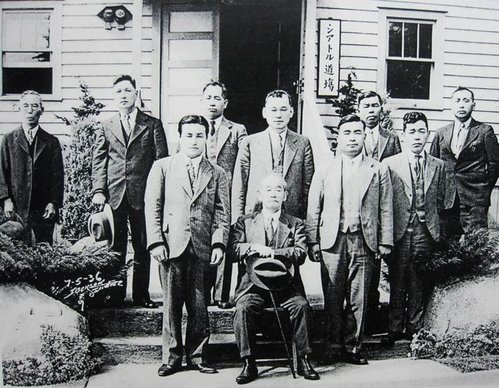
JIGORO KANO’S VISIT TO SEATTLE DOJO
The Seattle Judo Club, established in 1902, was reportedly the very first judo dojo to open on US soil. Jigoro Kano (1860-1938) seated in the center of this photograph, called at this dojo twice, once in 1936 and again in 1938.
After attending the International Olympic Committee meeting held in Cairo, Egypt, in 1937, he later visited several European cities, then New York, Seattle and finally Canada. On April 23, 1938 Kano headed home and left Vancouver Harbor on the Hikawamaru, which was scheduled to arrive at Yokohama on May 6. However, he did not live to see his homeland again. While headed home to Japan onboard the Hikawamaru, at the age of 77; he succumbed to pneumonia and died on this vessel on May 4, 1938.
World War II saw a different development of Judo. Instead of being used for sport, Judo was being taught as a combat skill. Those selected for commando and special forces training often achieved a high standard of expertise.
The Kodokan Today
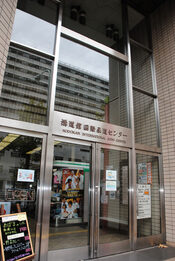 | 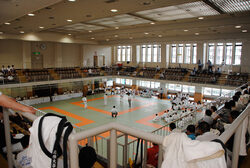 | 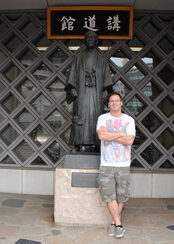 |
| Entrance to Kodokan | Inside the Kodokan | Josiah Taylor with statue of Kano |
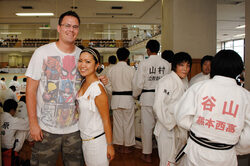 | 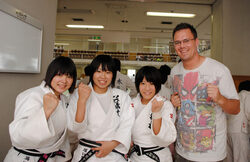 | 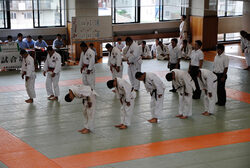 |
| Josiah and Shigeko Taylor | Josiah Taylor with Kodokan students | Inside the Kodokan |
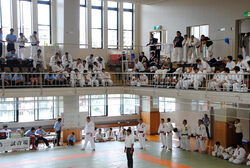 | 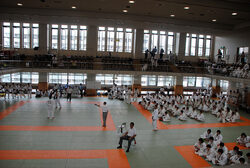 | 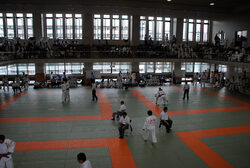 |
| Inside the Kodokan | Inside the Kodokan | Inside the Kodokan |


